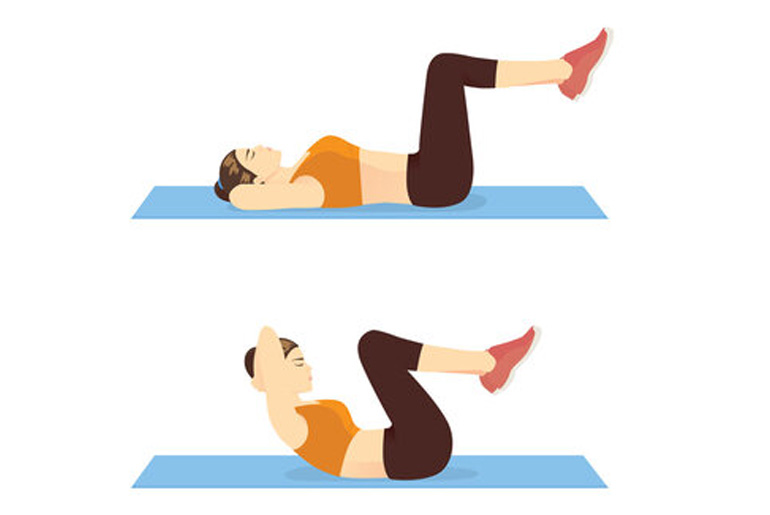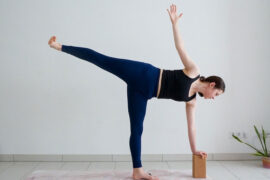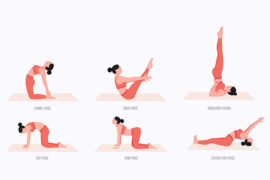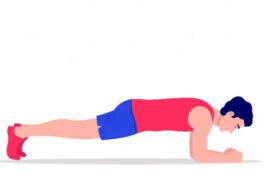The core serves as the fundamental support system for a wide range of movements, including daily activities like walking, lifting weights, and carrying heavy objects. When people think of strengthening the core, crunches often come to mind as one of the most popular exercises incorporated into various fitness routines, from boxing and HIIT-style bootcamps to Pilates.
However, the widespread popularity of crunches can lead to a common misconception, with many individuals performing them incorrectly. While crunches are known for their effectiveness in toning the abdominal muscles, executing them without proper form may result in more harm than benefit. The false sense of confidence associated with this well-known exercise often leads to errors in execution.
The risk of neck strain and discomfort during or after a set of crunches is a clear indicator of improper form. Feeling tension or an ache in the neck suggests that the movement is not being executed correctly. Taking the time to master proper form is essential not only for preventing neck strain but also for maximizing the effectiveness of crunches as a core-strengthening exercise.
To perform crunches with precision, individuals should focus on maintaining a neutral neck position, avoid straining the neck, and engage the core muscles throughout the entire range of motion. Emphasizing quality over quantity and incorporating controlled movements are key principles to ensure that crunches are executed safely and effectively. Seeking guidance from a fitness professional or trainer can provide valuable insights into proper form, helping individuals derive the maximum benefits from their core workouts while minimizing the risk of injury.
Benefits of Crunches:
Crunches are a popular abdominal exercise known for their benefits in strengthening the core muscles. Here are some key advantages and the specific muscles worked during crunches:
1. Improved Core Muscle Function: Crunches contribute to enhanced core muscle function, which is essential for overall stability, balance, and coordination. A strong core can positively impact sport performance and support other exercises by promoting better body control.
2. Enhanced Sport Performance: Strengthening the abdominals through crunches can have positive effects on athletic performance. A robust core is crucial for activities that involve rotational movements, such as swinging a golf club or throwing a ball.
3. Balance and Stabilization: Core strength developed from crunches aids in maintaining balance and stabilization during various physical activities. This is particularly beneficial in exercises that challenge balance, such as standing on one leg or performing movements on an unstable surface.
4. Posture Improvement: Regular incorporation of crunches into a fitness routine can contribute to better posture. Strengthening the abdominal muscles helps support the spine, reducing the risk of poor posture-related issues.
5. Reduction of Belly Fat: While spot reduction of fat is not possible, including crunches as part of a comprehensive fitness plan can contribute to overall fat loss. A combination of cardiovascular exercise, a healthy diet, and targeted abdominal workouts may help reduce belly fat over time.
6. Hypertrophy of Rectus Abdominis: Crunches primarily target the rectus abdominis muscle, leading to hypertrophy or growth in muscle size. This contributes to a toned appearance in the abdominal area, making crunches a suitable exercise for those aiming to sculpt their abs.
7. Focus on Specific Muscle Group: It’s essential to note that crunches target one of the four muscle groups in the core—the rectus abdominis. To achieve a well-rounded core routine, it’s advisable to incorporate exercises that engage the other core muscles, including the obliques, transverse abdominis, and erector spinae.
Number of Crunches Daily:
the advice from the personal trainer emphasizes a sensible and effective approach to abdominal workouts, discouraging the popular but often ineffective trend of doing a high number of crunches daily. Instead of adhering to arbitrary challenges like “100 Crunches a Day,” the focus is on incorporating crunches into a well-rounded ab routine.
The recommended strategy involves gradual progression, starting with 3 rounds of 10 crunches each, totaling 30 repetitions. The idea is to integrate crunches into an existing workout routine and incrementally increase the intensity of core exercises over time. This approach prioritizes the quality of movements over sheer quantity.
The trainer suggests creating a personalized workout routine, incorporating three different ab exercises to target various muscle groups. For instance, a routine might include crunches, bicycle crunches, and lower leg lifts, with each exercise performed for 10 repetitions per round. Completing three rounds of this circuit provides a comprehensive and effective ab workout.
The emphasis on variety, proper form, and incremental progression aligns with a holistic approach to fitness. Additionally, it highlights the importance of consistency in a workout routine, while cautioning against quick-fix challenges that may not yield sustainable results. Ultimately, the recommendation encourages individuals to listen to their bodies, enjoy their workouts, and pursue a well-balanced fitness plan for optimal results.
Common Mistake People Make When Doing Crunches:
A common mistake people make when doing crunches is pulling their necks forward with their hands during the movement. This error often occurs when individuals rely on their arms rather than their core muscles to lift their bodies up and forward. This action puts additional strain on the neck muscles and can lead to discomfort and pain.
Pulling the neck with the hands not only causes neck strain but also results in decreased engagement of the core muscles. Since crunches are designed to strengthen the core, failing to engage the abdominals properly is a significant mistake. To correct this error and perform crunches with proper form, it’s important to follow these steps:
- Engage the Core: Pull your navel in toward your spine to engage your core muscles. Squeeze your abdominal muscles to ensure active participation during the entire exercise.
Maintain contact between your low back and the ground.
- Hand Placement: Rest your fingertips gently behind your head, avoiding any pulling or straining on the neck. Keep your elbows wide, pointed out toward the sides of the room, rather than pulling them forward toward your knees.
Protecting Your Back and Neck During Crunches:
Protecting your back and neck during crunches is crucial to avoid strain and ensure proper form. Here’s a step-by-step guide on how to keep your neck and back safe when performing crunches:
Hand Placement:
- Place your hands behind your head with your fingertips gently supporting your head.
- Open your elbows out to the sides rather than pulling them forward towards your knees.
Head and Neck Support:
- Lift your head and neck off the ground, using your hands to support your head.
- Allow your head to rest comfortably in your hands to maintain proper spinal alignment.
Relax Shoulders:
- Despite using your arms to support your head, consciously relax your shoulders.
- Avoid hunching your shoulders up towards your ears.
Chin and Chest Alignment:
- Pretend you are holding an egg between your chin and your chest.
- Imagine that you don’t want to crack the egg, which helps in maintaining proper spinal alignment.
- Ensure your chin is not tilting down too far toward your chest or pointing up too high towards the ceiling.
Performing a modified crunch:
Performing a modified crunch can be a great way to work your core without straining your neck, especially if you’re still gaining confidence in tackling the full movement. Here’s a step-by-step guide on how to do a modified crunch:
- Starting Position: Lie down with your back on the floor or mat. Bend your knees and place your feet flat on the mat, ensuring a comfortable hip-width distance apart.
- Hand Placement: Place your hands behind your head with your elbows wide, opening them out to the sides.
- Core Engagement: Lift your chest up only halfway from the floor. This partial movement reduces strain on the neck while still engaging the core muscles. Ensure that your shoulder blades are off the ground, and tighten your abdominal muscles.
- Maintain Knee Bend: Keep your knees bent throughout the movement, maintaining a comfortable position for your lower body.
- Lowering: Lower your upper body back to the ground with control.
- Repetition: Repeat the movement for a set of 10 repetitions.
Variations of Crunches:
Here are four variations of crunches that target your core muscles:
1. Standing Bicycle Crunches:
- Stand up straight with your hands behind your head.
- Lift your right knee up to your chest while bringing your left elbow down to meet the right knee.
- Then, bring the left knee up and crunch the right elbow down to meet it.
Continue alternating sides.
- Squeeze your abs during the movement.
2.Modified Bicycle Crunch:
- Sit on your butt with your legs bent and heels resting on the ground.
- Position yourself as if you had just pulled yourself up into the top of a sit-up.
- Place your hands behind your head with your elbows wide.
- Twist your torso to the right and bring your right knee to meet your left elbow.
- Twist your torso to the left and bring your left knee to your right elbow.
3. Boat:
- Sit down with your knees bent and feet flat on the ground.
- Lean back slightly, engaging the core and keeping the back straight.
- Hold your arms out straight in front of you as you lift your feet off the floor.
- Keep your legs together, point your toes toward the ceiling, and form a “V” with your body.
- Hold for 10 seconds.
- For a modification, keep the knees bent and open as wide as your hips, with shins parallel to the floor.
4. Modified Forearm Plank Hold:
- Lie down on your stomach.
- Place your forearms flat on the mat and bend your knees so that they’re touching the mat.
- Engage your core and lift your body off the mat, balancing on your knees and forearms.
- You can stay in this position, or from here, raise your knees off the mat, creating a straight line from your head to your feet.
- Hold for the desired duration.
These variations provide a diverse range of exercises to engage your core muscles. Remember to maintain proper form, breathe steadily, and adjust the difficulty level based on your fitness level. If you have any existing health concerns or are new to these exercises, it’s advisable to consult with a fitness professional or healthcare provider before attempting them.
Disclaimer:
The information contained in this article is for educational and informational purposes only and is not intended as a health advice. We would ask you to consult a qualified professional or medical expert to gain additional knowledge before you choose to consume any product or perform any exercise.







